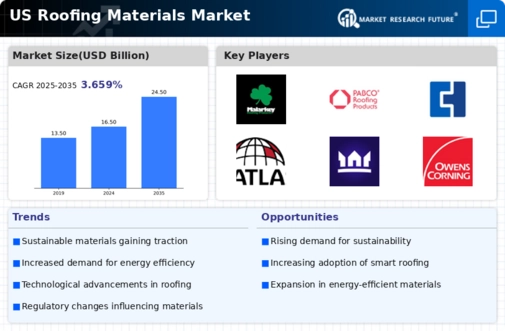Rising Construction Activities
The roofing materials market experiences a notable boost due to the increasing construction activities across the United States. As urbanization continues to expand, the demand for residential and commercial buildings rises, leading to a heightened need for roofing materials. In 2025, the construction sector is projected to grow by approximately 5.5%, which directly influences the roofing materials market. This growth is driven by both new constructions and renovations, as property owners seek to enhance the aesthetic and functional aspects of their buildings. Consequently, manufacturers in the roofing materials market are likely to see increased sales and opportunities for innovation in product offerings to meet the diverse needs of the construction industry.
Regulatory Standards and Compliance
The roofing materials market is significantly impacted by evolving regulatory standards and compliance requirements in the United States. Stricter building codes and environmental regulations compel manufacturers to develop products that meet specific performance criteria, such as energy efficiency and sustainability. For instance, the implementation of energy codes mandates that roofing materials reflect a certain level of solar energy, which influences product design and material selection. As a result, companies in the roofing materials market are investing in research and development to create compliant products, which may lead to increased operational costs but also opens avenues for premium pricing and market differentiation.
Increased Awareness of Climate Change
The roofing materials market is increasingly influenced by the growing awareness of climate change and its impacts on building practices. As consumers become more environmentally conscious, there is a shift towards selecting roofing materials that contribute to sustainability and resilience against climate-related events. This trend is reflected in the rising popularity of green roofs and materials with lower carbon footprints. In 2025, it is projected that eco-friendly roofing solutions will capture a larger segment of the market, potentially reaching 25% of total sales. Manufacturers are responding to this demand by developing innovative products that not only meet aesthetic preferences but also align with environmental goals, thereby enhancing their market position.
Growing Demand for Energy-Efficient Solutions
The roofing materials market is witnessing a surge in demand for energy-efficient solutions, driven by rising energy costs and environmental awareness among consumers. Homeowners and businesses are increasingly seeking roofing materials that offer superior insulation and reflectivity, thereby reducing energy consumption. In 2025, it is estimated that energy-efficient roofing products could account for over 30% of the total roofing materials market. This trend is further supported by incentives and rebates offered by government programs aimed at promoting energy efficiency. Manufacturers are responding by innovating and expanding their product lines to include materials that not only meet energy efficiency standards but also provide long-term cost savings for consumers.
Technological Advancements in Material Production
Technological advancements in material production are reshaping the roofing materials market, enabling manufacturers to create more durable and sustainable products. Innovations such as advanced polymer technology and improved manufacturing processes enhance the performance characteristics of roofing materials, including longevity and resistance to extreme weather conditions. In 2025, it is anticipated that the adoption of these technologies will lead to a 10% increase in the market share of high-performance roofing materials. This shift not only benefits manufacturers through increased sales but also provides consumers with better options that align with their needs for durability and sustainability. As a result, the roofing materials market is likely to see a competitive edge driven by these technological improvements.



















Leave a Comment